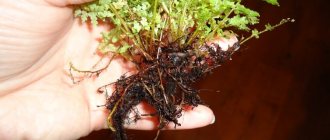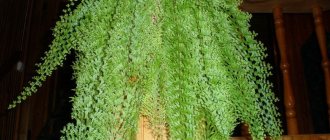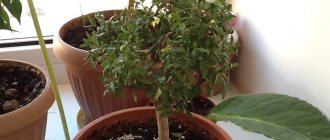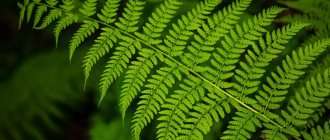In garden plots, home areas, parks and gardens, natives of the wild - ferns - have firmly established themselves. Perennial herbaceous ornamental plants with beautiful openwork leaves can be grown in shady and dimly lit areas - they are so undemanding in terms of lighting and easy to care for. One of the cultivated representatives of ferns is the ostrich fern (family Onocleaceae). It is cultivated not only for the decoration of the territory, but also as a plant, the young shoots of which can be eaten, and the rhizomes can be used for medicinal purposes.
Description: varieties and varieties of ostrich
Ostrich is a fern belonging to the Onocleaceae family. Its native climate is temperate. The culture got its name because of the structure of the leaves, which is why it is sometimes called ostrich feather, as well as black fern or German ostrich fern. Characteristics:
- height - up to 2 m;
- leaf arrangement is vertical;
- form - feathery fern;
- taller leaves form a funnel, in the middle of which there are low leaves with spores;
- color - emerald green for large leaf blades and brown for spore-bearing ones;
Ostrich leaves
- the size of the main leaves is 1.5 m in length and about 30-40 cm in width;
- The root system is vertical, powerful and long; underground creeping shoots extend from the roots.
Attention! Ferns of any variety oppress all neighboring plants.
At the beginning of the growing season, all the fronds of the plant are tightly curled. Then they gradually unfold and form the very funnel for which this fern is valued. The ostrich looks most attractive in June, as can be seen in the photo. Large leaves die off in the fall, and overwintered fronds with spores unfold and shed seeds in the spring.
There is no division into varieties as such for the common ostrich. Some botanists identify the Pennsylvania variety, but only a specialist can distinguish it. The common fern has a relative - the oriental fern. It differs in the shape and size of the feathers of the first row. The root system of its varieties is less aggressive, but this fern is more difficult to care for and reproduce.
Ostrich in folk medicine
Ostrich is not used in the treatment of any diseases in traditional medicine. But traditional healers often use this plant as one of the main components for preparing decoctions and infusions. In order to understand what effect this plant can have on humans, you need to understand its chemical composition. As it turns out, he is quite rich:
- ascorbic acid;
- tannins;
- coumarin derivatives;
- essential oils;
- saponins;
- starch;
- alkaloids;
- fats;
- hydrocyanic acid;
- tannic acid;
- a nicotinic acid;
- carotene.
In folk medicine, both aerial parts of the plant and rhizomes are used. Ostrich can help get rid of the following ailments:
- disorders of the gastrointestinal tract;
- painful menstruation in women;
- headaches of various origins;
- sleep disorders and neuropsychic state of a person;
- helminths in the human body;
- disturbances in the functioning of the respiratory system, attacks of suffocation;
- pain syndrome of various origins;
- epilepsy and seizures;
- cough;
- mechanical damage to the skin, wounds.
Thus, ostrich, when skillfully prepared and combined with other medicinal plants, can have an analgesic, antiseptic, sedative, anthelmintic, anticonvulsant, and antitussive effect. Since ancient times, fern rhizomes have been considered a good helper for women who experience too much pain during menstruation. For external use, compresses from the leaves are used, and for internal use, alcohol tinctures and decoctions are used. When planning to use ostrich to treat any ailments, be sure to remember:
- some varieties of fern are poisonous and their independent use can be dangerous;
- Pregnant women and women who are breastfeeding should refuse treatment with such folk remedies;
- The use of folk remedies based on ostrich is prohibited in the treatment of children. This also applies to all other medicinal herbs. Such self-treatment can cause severe allergic reactions;
- Ostrich-based folk remedies will not help in the treatment of acute phases of diseases. It's always a good idea to see a traditional doctor first;
- An overdose of ostrich can have a negative effect on a person. He may feel weakness, aching bones, depression of respiratory function, slow pulse and low blood pressure, cramps, nausea, and diarrhea.
No matter what wonderful properties ferns have, they should be used for treatment very carefully and only after consulting a doctor.
Common ostrich: planting a plant
Seedlings 2-3 years old are suitable for planting in open ground. Choose a shaded place on the site for them. In the sun the ostrich will grow, but will not be large. Flower growers advise planting the plant in groups of 5-7 pieces.
The planting pattern is as close to natural as possible. For example, irregular triangles. At the same time, keep a distance of 0.3-1 m. The advantage of this method is that in a couple of years the fern will independently increase its number vegetatively. All you have to do is manage to remove unnecessary plants, and from all the rest, form a green decoration for the site.
Choose a shaded place on the site for the ostrich
Ostrich. Photo
Ostrich is one of the few plants that can decorate a shady corner of your garden. It will look great at stone bases, along paths. If you are planting the plant in a group with other plants, then place the ostrich plant in the background. Its tall carved leaves will highlight the beauty of the rest of the composition. It is also appropriate to plant ostriches near ponds, in a mixborder, or in a stone garden. These spectacular plants can be combined with the following varieties of ornamental plants in the garden:
- peonies;
- irises;
- daylilies;
- hosts;
- hazel grouse;
- tulips;
- irises;
- delphiniums.
Ostrich can also be grown for cutting. With their help, they create a beautiful emerald background in bouquets. These plants are also used for drying. Dried ostriches look no less impressive; they make excellent winter bouquets and compositions.
Plant care, fertilizer and feeding
Ostrich is a strong and viable plant. Therefore, growing it is a pleasure. First of all, neighboring garden, vegetable or ornamental crops, if any, need care and protection. Gardeners use artificial barriers. For example, a wide plastic tape dug around the perimeter of the planned site. For planting in a flowerbed, you can use a large bucket without a bottom, with which the fern is buried.
Attention! Growing an ostrich in one place without problems is possible for 6-7 years. Then the plant can be replanted. The procedure is performed in the spring. There is no need to remove the entire plant - it is enough to take only part of the rhizome with a bud. In a new location, the plant requires abundant watering to adapt.
Other aspects of caring for the common ostrich in open ground:
- Control humidity. During drought, the plant should be sprayed.
- For the winter, the ostrich needs to be covered only if prolonged frosts of -10 °C or stronger are expected in your region.
- Fern does not tolerate heat from +25 °C.
- Watering is moderate. If there is no rain for a long time, increase the dose of water.
This fern does not need fertilizer. But still, flower growers sometimes use them. Any organic and mineral mixtures will do. Apply fertilizers approximately once a month during the first year of the plant’s life, at your discretion.
Planting in the ground, further care
Any site is suitable for planting a divided plant or ostrich seedling, but it should be noted that in a sunny place it will not grow more than 1 m in height, the shoots will be less saturated in color. Where there is shading, the bushes are tall, the color of the leaves is juicy and rich.
It is better not to plant ferns along narrow paths or close to low-growing crops - as they grow, they take away light and interfere with passage.
Fern care:
- water regularly - the soil should always be moist (the root system does not develop in dry soil), the amount of moisture depends on weather conditions;
- It is not necessary to fertilize, but when applying fertilizers to neighboring crops, you can also feed ferns;
- thin out every 3-4 years, remove excess shoots annually;
- to prevent sprawl across the territory, the area can be fenced by digging slate sheets around the perimeter, deepening it by 10-15 cm and leaving at least 10 cm on top;
- cover for the winter only in severe frosts;
- in the spring, treat with a solution of copper sulfate to prevent fungal infections.
A beautiful emerald ostrich, planting and caring for which does not require special skills, will decorate any corner of the garden plot or local area. Maintenance requirements are minimal - regular watering and thinning.
Common ostrich: plant propagation
Like other ferns, the ostrich fern is strong in independent reproduction by spores. Collected spore capsules are a fairly effective and at the same time troublesome method. The best time to collect spores is late summer-early autumn. They are suitable both for storage in a dry place and for immediate planting for propagation. In any case, peat bedding is suitable for seedlings. Disinfect it first.
Ostrich grows well on its own
Deepen the spores into the substrate, then water and cover with glass or film. Among the care measures, the crops only need periodic moistening. Sprouts will appear in 25-40 days. Transplant them immediately into special soil for ferns, which can be purchased at the store. Further care and cultivation of the plant consists of maintaining a high level of humidity and, if necessary, replanting it in a larger pot. In this mode, young plants will live for several years before being planted in open ground.
An alternative to spores is vegetative propagation by root shoots. To do this, look for them in the top layer of soil. Plan the work for early spring or August. The shoot should have 2-3 buds:
- Cut the shoots to about 10 cm in length.
- Plant them in open ground at intervals of at least 50 cm.
Attention! At the first stage of development, fertilizers are not needed for ostriches planted in any way.
Contraindications
- pregnancy and breastfeeding;
- age up to 14 years;
- serious kidney and heart diseases;
- stomach ulcer;
- allergy to alkaloids;
- intolerance to components.
Damp fern shoots and spores can accumulate toxins . To avoid poisoning and not to confuse black saran with other poisonous species of fern, treatment should begin under the supervision of an experienced herbalist .
Ostrich diseases and pests
The common ostrich can take a liking to the Tarfin marsupial mushroom. This parasitic organism causes leaf spot. In addition, it sometimes touches neighboring ornamental and fruit trees. Affected tissues should be cut off and burned, and the plant should be sprayed with a fungicide. Spring treatment of plantings with copper sulfate or Bordeaux mixture helps as a preventive measure.
Take preventive measures against fungal diseases
Benefits of fern for the body:
Ferns are considered record holders for their ability to accumulate silicon, and ostrich is no exception. Silicon is involved in the absorption of many mineral salts and vitamins, prevents osteoporosis, stimulates the immune system, improves the condition of the skin and nails, strengthens connective tissue, cartilage, tendons and blood vessels.
Once in the body, it “glues” the cells of microorganisms, bacteria, influenza viruses, hepatitis, candidiasis to its molecules and neutralizes them. Therefore, a sufficient amount of silicon in the body is the key to preventing stroke and heart attack, diabetes, cancer and many other diseases.
In addition, the common ostrich fern has the following effect:
- - astringent;
- - antitussive;
- - antispasmodic;
- - painkillers;
- - sedative;
- - anticonvulsant;
- - antiepileptic;
- - anthelmintic;
- - anti-inflammatory;
- - antiseptic.
Ostrich: combination with other plants
A group planting of ostrich birds is a beautiful combination in itself. When choosing other companions, keep in mind that the fern growing season begins late. In the design of plots, the camouflage properties of ostrich grass are used to hide early fading crops: crocuses, scillas, etc.
Fern in company with moss, driftwood and stumps will create a forest composition on the site. This photo-atmospheric installation will be complemented by saxifrage, primrose, loosestrife or creeping tenacious. The combination of ostrich with leopard, daylilies, decorative varieties of cereals and irises looks interesting.
Application in landscape design
The main use of the ostrich is in the landscape design of individual plots or park areas. The photo shows that the ostrich feather fern can be a decoration for almost any composition. It can be planted among stones and boulders or on the banks of ponds.
Ostrich goes well with tall, large flowers, like irises or peonies.
When grown in shady areas, ostrich can keep company with hostas or daylilies.
You can often find ferns next to early spring flowers - tulips and daffodils; as the ostrich fern grows, it covers the already faded plants.
Attention! It is not recommended to plant ostrich grass along narrow paths, since as it grows it will interfere with the passage.
As for the undesirable neighborhood, it is not recommended to plant ferns next to light-loving low flowers (zinnias, petunias, marigolds), since the ostrich will block the plantings from the sun's rays. It should also be remembered that the plant has a highly developed, rapidly growing rhizome, which can crush weaker neighbors.
Requirements for conditions of detention
Common and Oriental ferns tolerate low temperatures down to -10°. If the region has harsher winters, the plants need shelter.
The crop does not tolerate heat well. Already at temperatures above +25°, the leaves begin to wither and dry out. This is a characteristic feature of all ferns. Therefore, it is important to regularly water the plants in dry weather, including overhead spraying. The soil should always remain moist.
Despite the Ostrich's unpretentiousness, the plant needs the right choice of planting site and protection from the wind.











